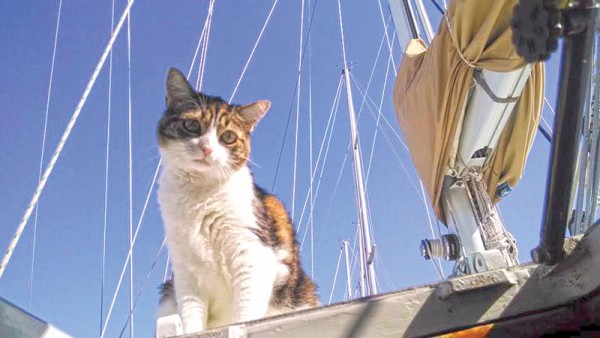What It's Like to Go Cruising with Cats
Sometimes I look our cats right in the eye and say, “You loved Spain, didn’t you?” or I’ll say, “Doesn’t this remind you of Africa?” or “You really liked this food in Portugal!” And they just look back at me. Truth is, I really believe they did love each place we sailed to. They sailed with us across the ocean to Europe, Africa, and a bunch of islands along the way and back. They did not necessarily love the ocean, but they got to like it a little over time. They clearly were able to tolerate the motion better toward the end of the first crossing and even ventured outside (with careful supervision) during the second crossing. But love the ocean? Not so much. However, when we reached a destination, they would come out and sit on deck, posing like little cat models with perfect posture, their feet together in front of them, ears up and alert, nose twitching at new smells, and facing into the breeze. Sometimes they closed their eyes and seemed to smile.

The starting of the engine has become a sport with them. On our boat, we have a routine where we first open the fuel line and then turn on the alternator before we turn the key. Each of these things involve a sound. The forward engine room door has a sound when it is opened to reach the fuel line, then the aft door. The key makes a buzz, and then the engine rumbles to life. At first the cats would run and hide at the turn of the key. Now, they are gone when the first engine door is even barely unlatched. But if we run the engine for more than an hour, they eventually come out and lie around and clean themselves, as if the engine is not so evil after all.
They seem to like sailing as long as the waves are in the two- to three-foot range. In the ocean, we had waves 20 feet high or more. That is a little over three times the size of an average adult human. But our cats are about 12 inches high. One foot. These waves were 20 times their height. No wonder they prefer flatter water! But still, they learned to gimbal their bodies, acquired very good sea legs, and eventually took to sailing quite well.
Taking our two cats, named Dabola and Perkins, on our planned, two-year transatlantic adventure was not a decision. They are part of the family. They were born in my office in 2008. The mother was a feral cat who stowed away inside the office and gave birth to four kittens. We kept two of them and found homes for the other two kittens. (We still stay in touch with them.) We moved our kittens to the boat as soon as they were old enough to leave their mother. It was that same year that we pulled the rig and got very serious about our departure date. By the time we left the dock heading toward bluewater adventures, our kittens were three years old, and the boat was their home and sanctuary. They had already experienced sailing and the evil engine. So the main differences of the big trip were the long bumpy passages across the ocean, not stopping at night in a calm creek, and all the new sights, sounds, and smells of foreign ports.
Before we left, we consulted with our vet. She wrote an extensive medical history of their care in case we needed this for port entry. She also gave us great instructions on several emergency scenarios. This along with a good cat care book allowed us to feel prepared to be their best parents. We knew that at some point we would need to visit a vet abroad for annual shots. We were in Spain, in a town called Ayamonte, about the same time their annual shots were due. There was a vet across the street from the marina’s parking lot. It couldn’t get more convenient, so we made an appointment. When we arrived with the cats, the woman at the front desk asked for our passports. This was confusing since we weren’t there on official business. Then she realized that Americans don’t have to have passports for pets. (Europeans do.) That is when she asked if we would like to have pet passports. Of course we would! So right there, she made us official Spanish passports complete with the cats’ updated shot information and photos. These documents became our favorite souvenirs of our travels. Not only were they really cool, they also were very useful to break the ice of some of the lesser friendly immigration officials that we met. We would hand over our own passports along with the cat ones, and these gruff officials would break into huge smiles. Then we’d hear stories about their own cats.
Although our boat is still ready to go back to sea, we are now solidly back in the world of hard work and gainful employment. Our cats are still aboard with us and healthy and happy. They enjoy local sailing just fine. And we hope that when the day comes for us to once again head out to open ocean and other time zones, these two little buddies will come along! They are good crew.
By Cindy Fletcher-Holden




